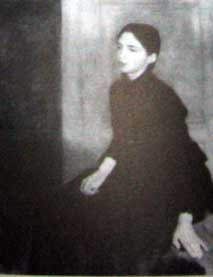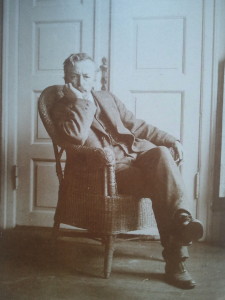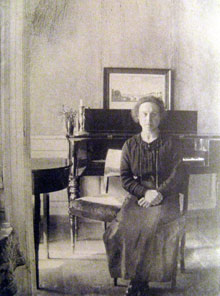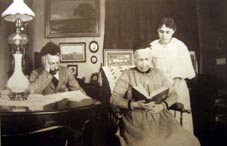Vilhelm was a Danish painter, born in Copenhagen and it was there, in the old quarter, where he mainly lived and worked. He painted portraits, landscapes and many room interiors which frequently contained a single figure that was seated or standing. Hammershøi’s father was a wholesale merchant and the family enjoyed a good standard of living but it was his mother who saw the talent residing within Vilhelm and she dedicated herself to promoting his career.
Hammershøi’s elder brother was the painter Svend Hammershøi and he studied under N.C. Kierkegaard. Hammershoi began his training at 8 and by the time he was in his mid-teens he was already studying at the Royal Academy of Art in Copenhagen. Towards the end of his study he also learnt at the Free Study School which offered a more liberal approach. Another well known Danish artist PS Krøyer was his teacher. He is shown here (above) with his wife in a double portrait by Vilhelm. He made an impressive debut in the art world with the portrait shown above, of his sister, painted in 1885 and titled Portrait of a YoungGirl. He was still only 21 but already his originality was shining through and showed a different direction to the accepted normalities of naturalism. This labelled him controversial in the world of Danish Art. He married Ida Ilsted (right) in 1891 and she provided the inspiration for many of his future works and is often the lone figure seen in his paintings. They lived a relatively quiet life, apart from Ida’s reported fiery temperament, and had no children. They did however travel together throughout Europe, including Paris, Berlin and London. Later in his life he lived in the old merchant house at Strandgade in Copenhagen and he painted the interior of this house more than sixty times. Hammershøi died of throat cancer in 1916 in Copenhagen at the age of 52.Hammershøi’s Style
Many of his paintings show empty rooms or often include the profile, or view from the back, of his wife in a long dark dress. These interior paintings always show rooms inside his own home and due to their popularity Hammershøi’s other subjects have been slightly overshadowed. He has painted sublime landscapes and architectural pictures that emit a lonely, deserted and empty feeling. There are definite elements of modernism in his work from the use of a muted palette and his frequent use of exaggerated light to the creation of similar yet subtly different paintings. Yet it is the interiors that remain the most popular due to the way they emit a solitary atmosphere devoid of life but still providing a real emphasis on a feeling of space.
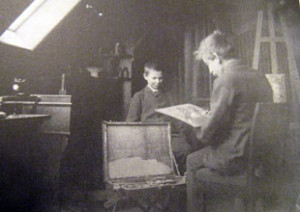
Hammershøi and his young brother
Hammershøi Conclusion
Hammershoi was seen in his own time as an artist who it could be said looked backwards and seemed old fashioned due to his tonal paintings.
This is particularly so if comparison is made to striking colourful modernist artists of Hammershoi’s time such as Henri Matisse (1869-1954).
In fact Hammershoi is somewhat of an enigma to place and perhaps that is where his popularity stems from. From being anti-modernist in his own time, he reaches out toour very modern world even if he can’t quite be placed as symbolist, existentialist or modernist.


